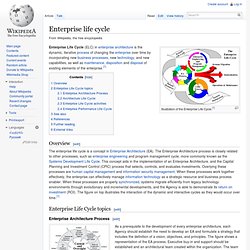

» Enterprise Agility – Patterns - People10. I had written a blog earlier on ‘how agile are you : an assessment”? It created some debates on various types of agility across the enterprise.. ‘Agile for me’ is not the same as ‘agile for you’. We are agilist, hence we don’t impose any one person’s version onto others. We are quite free to adopt the methods we choose. Yet, the question remains. Thanks to Rakesh, I have this nice illustration with which I can share with you the evolution of agile across different types of IT application scenarios. Portfolio management tools draw roadmap for business transformation. The enterprise architect’s world today is in constant flux.
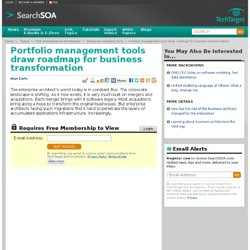
The corporate landscape is shifting. As it now exists, it is very much built on mergers and acquisitions. Each merger brings with it software legacy. Most acquisitions bring along a hope to transform the original businesses. But enterprise architects facing such migrations find it hard to penetrate the layers of accumulated applications infrastructure. Portfolio management tools are being used to move newly complex organizations forward. However, portfolio management is not a slam dunk.
“We are still waiting for the emergence of a more unified set of tools and approaches,” he says. Portfolio management or application portfolio management (APM) did not grow directly from project portfolio management, but it was highly influenced by project management methods. “Enterprise architects can go and draw lines but the tooling has no financial view and no resource view and no scheduling view,” he says. Is your software app portfolio out of control?
While they may be the last to admit to it, many organizations have an app problem.
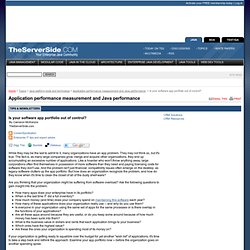
They may not think so, but it's true. The fact is, as many large companies grow, merge and acquire other organizations, they end up accumulating an excessive number of applications. Like a hoarder who won't throw anything away, large corporations often find themselves in possession of more software than they need and paying licensing costs for software they don't use. And the problem isn't just financial; compatibility issues often emerge on the desktop, as legacy software clutters up the app portfolio.
But how does an organization recognize the problem, and how do they know when it's time to clean the closet of all of the dusty shelf-ware? Are you thinking that your organization might be suffering from software overload? Www.hpl.hp.com/techreports/2012/HPL-2012-123.pdf. Business Enterprise Architecture. Official Release Dated – March 11, 2011 and published March 18, 2011 Under the Office of Deputy Chief Management Officer, the Business Transformation Agency (BTA) annually delivers the Business Enterprise Architecture (BEA) for the Department of Defense (DoD) Business Mission Area (BMA) to help defense business system owners and program managers make informed decisions.

The BTA published the latest official BEA 8.0 release, March 18, 2011. Introduction. TOGAF is a framework - a detailed method and a set of supporting tools - for developing an enterprise architecture.
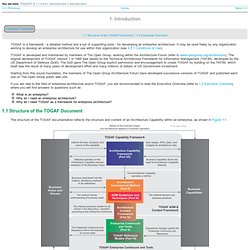
It may be used freely by any organization wishing to develop an enterprise architecture for use within that organization (see 4.5.1 Conditions of Use). TOGAF is developed and maintained by members of The Open Group, working within the Architecture Forum (refer to www.opengroup.org/architecture). An Enterprise Architecture framework definition - Enterprise Architecture Matters. Continuing one of my own recent posts: "the question is for us if we do need an EA framework...
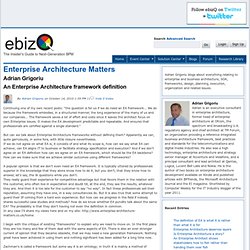
We do because the framework embodies, in a structured manner, the long experience of the many of us and our companies... The framework saves a lot of effort and costs since it leaves the architect focus on own Enterprise issues. It makes the EA development predictable and repeatable. And ensures that professionals are certified against a single standard. " But can we talk about Enterprise Architecture frameworks without defining them? A popular opinion is that we don't even need an EA framework.
I begin with the critique of existing "frameworks" to explain why we need to move on. But what is a framework or what should it be? " Alex Matthews' blog about Enterprise Architecture. "To Be" Enterprise Architecture. HSSP - Reference Architecture. Stephen Hufnagel PhD is one of the project facilator and this wiki page editor.
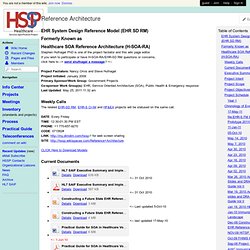
If you wish to participate or have H-SOA-RA/EHR-SD RM questions or concerns, click here to --> send shufnagel a message <--Project Facilators: Nancy Orvis and Steve HufnagelProject Initiated: January 2009Primary Sponsor/Work Group: Government ProjectsCo-sponsor Work Group(s): EHR, Service Oriented Architecture (SOA), Public Health & Emergency responseLast Updated: May 25, 2011 11:32 am Weekly Calls The related EHR-SD RM, EHR-S CI-IM and HF&EA projects will be statused on the same call.DATE: Every FridayTIME: 12:30-01:30 PM ESTPHONE: +1 770-657-9270CODE: 071582#LINK: for web screen sharingSITE: Here to Download Models Current Documents Executive Summary Project Intent Project Scope Project Objectives and Deliverables Project Schedule Year 1 Chronology of Events 17-May-11 11-Jan-11 EHR SD RM prototype XML (must put *.XML and *.XSL in same directory and click on *.XML) 05-Oct-10 May 14, 2010 May 7, 2010 Apr 30, 2010.
Enterprise architecture planning. Levels of Enterprise Architecture Planning.[1] Enterprise Architecture Planning (EAP) in Enterprise Architecture is the planning process of defining architectures for the use of information in support of the business and the plan for implementing those architectures.[2] Overview[edit] One of the earlier professional practitioners in the field of system architecture Steven H.
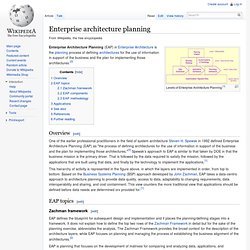
Spewak in 1992 defined Enterprise Architecture Planning (EAP) as "the process of defining architectures for the use of information in support of the business and the plan for implementing those architectures. This hierarchy of activity is represented in the figure above, in which the layers are implemented in order, from top to bottom. EAP topics[edit] Zachman framework[edit] EAP defines the blueprint for subsequent design and implementation and it places the planning/defining stages into a framework.
Enterprise life cycle. Illustration of the Enterprise Life Cycle.[1] Enterprise Life Cycle (ELC) in enterprise architecture is the dynamic, iterative process of changing the enterprise over time by incorporating new business processes, new technology, and new capabilities, as well as maintenance, disposition and disposal of existing elements of the enterprise.[1] Overview[edit]
